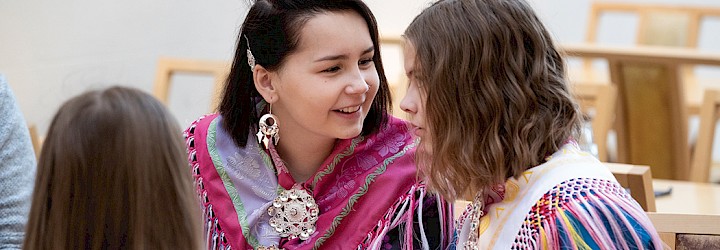 At the Arctic Frontiers 2021 conference, Joel Clement held the keynote for the “Building the future” panel. His inspirational speech was an ode to empowering youth and building a resilient Arctic – and a reflection on the discussions of the 2020 Arctic Resilience Forum.
At the Arctic Frontiers 2021 conference, Joel Clement held the keynote for the “Building the future” panel. His inspirational speech was an ode to empowering youth and building a resilient Arctic – and a reflection on the discussions of the 2020 Arctic Resilience Forum.
Joel Clement is an Arctic Initiative Senior Fellow at the Harvard Kennedy School’s Belfer Center for Science and International Affairs. A shortened version of his speech is printed here.
While we speak of the future conditions of the Arctic, we don’t talk enough about the people who are going to be in the driver’s seat in that future Arctic – the youth and early career folks. […]
But what does this future Arctic look like?
While imagining this future I was startled to realize that by the time today’s twenty-year-olds are my age, hitting their professional stride, it will be the year 2055. At that point, if we do our job right now, the rate of warming in the Arctic should have peaked. This is not to say the Arctic will then start cooling and eventually get back to normal, because that is not going to happen on a timeframe relevant to society. But the rate of change, which is currently accelerating at an alarming rate, should begin to slow. If we do our jobs now to limit greenhouse gas emissions.
An Arctic Vision
In 2055, having grown up with rapid change, never knowing the old status quo, these youth will know what they’re up against and will have developed new systems to thrive in a warmer, wetter, greener, browner Arctic. They will know how to minimize the damage from wildfire; they’ll have developed protocols to protect the lands and waters from invasive species, they’ll have learned how to ensure freshwater security, and better anticipate and predict what have become highly uncertain wildlife migrations.
Indigenous communities, supported by a society finally attuned to social justice, will have achieved equal status, legal preferences and unassailable land rights and be known as the climate change innovators of the North, partly because an influx of new resilience investments helped unleash the powers of Indigenous ways of knowing and being.
New sources of financial capital will be drawn to the warming Arctic. Public infrastructure in the North will be world class, and communities – the heart and soul of the Arctic that were so stressed by the pandemics of the early 2020s – will be just as connected to the internet’s health, education, entertainment and political opportunities as Paris or London. Search and rescue capacity will be widespread, and development will be enhanced and improved through the use of ecosystem-based approaches.
The vast open spaces of the Arctic will have attracted an influx of new arrivals, some of whom bring important skills such as health care and education, and others who bring much needed tourist revenue thanks to a tourism strategy, co-developed by Western and Indigenous experts, that protects areas of cultural value and minimizes impact on ecosystems.
The Arctic will be powered by renewable energy sources and the fossil fuel infrastructure of the past will be converted to computer server farms and energy storage facilities. There will still be extractive industry, but it will focus on rare earth metals rather than fossil fuels and be tightly regulated to ensure that ecosystem and social impacts are rare and local jobs are abundant.
It’ll be a very different Arctic but, given the circumstances, one that the people of the Arctic can thrive in. The open lands and waters will still retain the remote wildness that makes the Arctic so unique, and communities will enjoy a cultural renaissance as preserved languages are once again taught in schools and the old ways are adapted to a new climate.
Now, obviously some of this vision is fantasy, and I fully admit that the version I just described may not reflect all of your interests or priorities, but I do think it’s time to start imagining our own success. […]
Reaching the Vision
So, how can we achieve a positive vision for the Arctic? First off, listen to the youth. Some of you know that the Arctic Council’s second Resilience Forum took place this fall over the course of 10 weeks, and the first session was devoted to Indigenous youth leadership.
An impressive lineup of youth talked about what they worry about, what leadership means to them, how they learn, and how they want to be heard.
[…] I had a couple of take-homes from that session. First, we have to stop being surprised when youth voices bring smart and important issues to the fore, they are truly on the ball. Second, the youth feel and see social ills differently than us aged folks. We plan into the future because it’s strategic, but for the youth, it’s out of necessity. As obvious as this may seem, it has not historically led to a seat at the table for youth voices, for the most part. This needs to change. We need that input now. […]
So here are my top five recommendations for building the Arctic future:
- Focus on Resilience. Resilience is not just another buzzword, or a synonym for climate adaptation. Rather, it describes the enabling conditions and quality of relationships between interconnected social and ecological systems that allow them to best recover and thrive through crises or shocks. Indigenous knowledge and decades of research show that fostering these conditions makes for more resilient communities. […]
- Teach Leadership. Leadership is one of those enabling conditions and it doesn’t come along by accident. […] We need to be more deliberate about fostering leadership in the Arctic. This means training, mentoring and making space for youth voices. And trust me, there is a huge demand for this – the Arctic is teeming with youth who are eager to learn and lead. […]
- Elevate Indigenous Knowledge. Indigenous ways of knowing are and will be essential to navigating rapid change. […] We need to explore pathways to the co-production of knowledge that honor and elevate Indigenous knowledge, and Indigenous knowledge holders, in Arctic society.
- Embrace Public Service. […] [I]n my opinion, not enough of our best and brightest are choosing public service. By public service, in this case, I mean working within public institutions, the governments and agencies making decisions that affect how, and for what, we live our lives. These institutions need leaders and innovators, they need future-casters, they need dedicated staff to ensure that misguided politicians cannot seize the reins and drive us into a ditch. In my view, there is no higher calling. […]
- Innovate. We need to shake off, at every opportunity, the “way we do things” in the Arctic. It’s a new Arctic now, and change is accelerating beyond the ability of existing structures to keep pace. When I was first learning about resilience, about twenty years ago, what struck me in the adaptive models was the degree to which rigidity increased risk. We don’t need to cast everything aside, that would be counterproductive, but we need to add flexibility where we can. For example the Arctic Council, as an elastic and adaptable institution, would be well positioned to influence positive change, but as a rigid and unchanging edifice it would hold back progress. […]
Not to overstate the obvious, but without question it’s the youth who are best positioned to disenthrall themselves from the dogmas of the quiet past and explore new approaches unconstrained by convention. It’s our job to pave the way so they can get to work on that as soon as possible.
Every time I’m asked what gives me hope during dark moments, I always say the same thing: The youth. Whether it’s climate change or other issues, the youth have truly inspired us, particularly in the last couple of years.
It’s past time we stopped relying upon them for hope and offer some in return. Rather than expecting them to light us up, let’s light them up in every way we can so they can eclipse us with their success. […]
Source: Arctic Council


